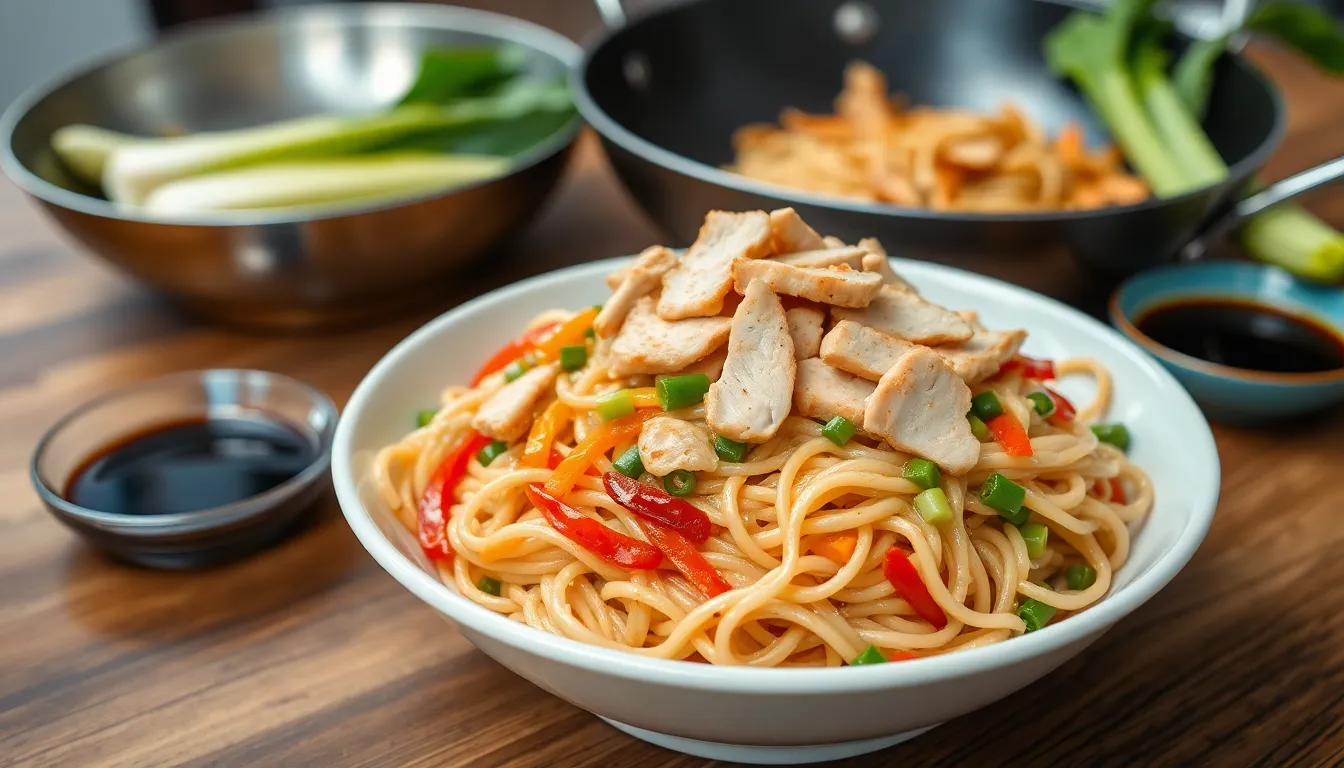Ingredients
Creating authentic lo mein starts with gathering the right combination of fresh ingredients and pantry staples. These carefully selected components work together to deliver the rich umami flavors and satisfying textures that make this dish irresistible.
For the Lo Mein Noodles
- 12 oz fresh lo mein noodles or 8 oz dried Chinese egg noodles
- 1 tablespoon vegetable oil (for tossing cooked noodles)
- 1 teaspoon sesame oil
For the Sauce
- 3 tablespoons soy sauce (low sodium preferred)
- 2 tablespoons oyster sauce
- 1 tablespoon dark soy sauce (for color)
- 1 teaspoon sesame oil
- 1 teaspoon cornstarch
- 2 cloves garlic, minced
- 1 teaspoon fresh ginger, grated
- 1/4 teaspoon white pepper
- 1 teaspoon sugar
For the Vegetables and Protein
- 8 oz protein of choice (chicken breast, beef sirloin, shrimp, or tofu), sliced thin
- 2 cups napa cabbage, chopped
- 1 large carrot, julienned
- 1 bell pepper, sliced thin
- 4 oz mushrooms, sliced
- 3 green onions, cut into 2-inch pieces
- 1 cup bean sprouts
- 2 tablespoons vegetable oil (for stir-frying)
Equipment Needed
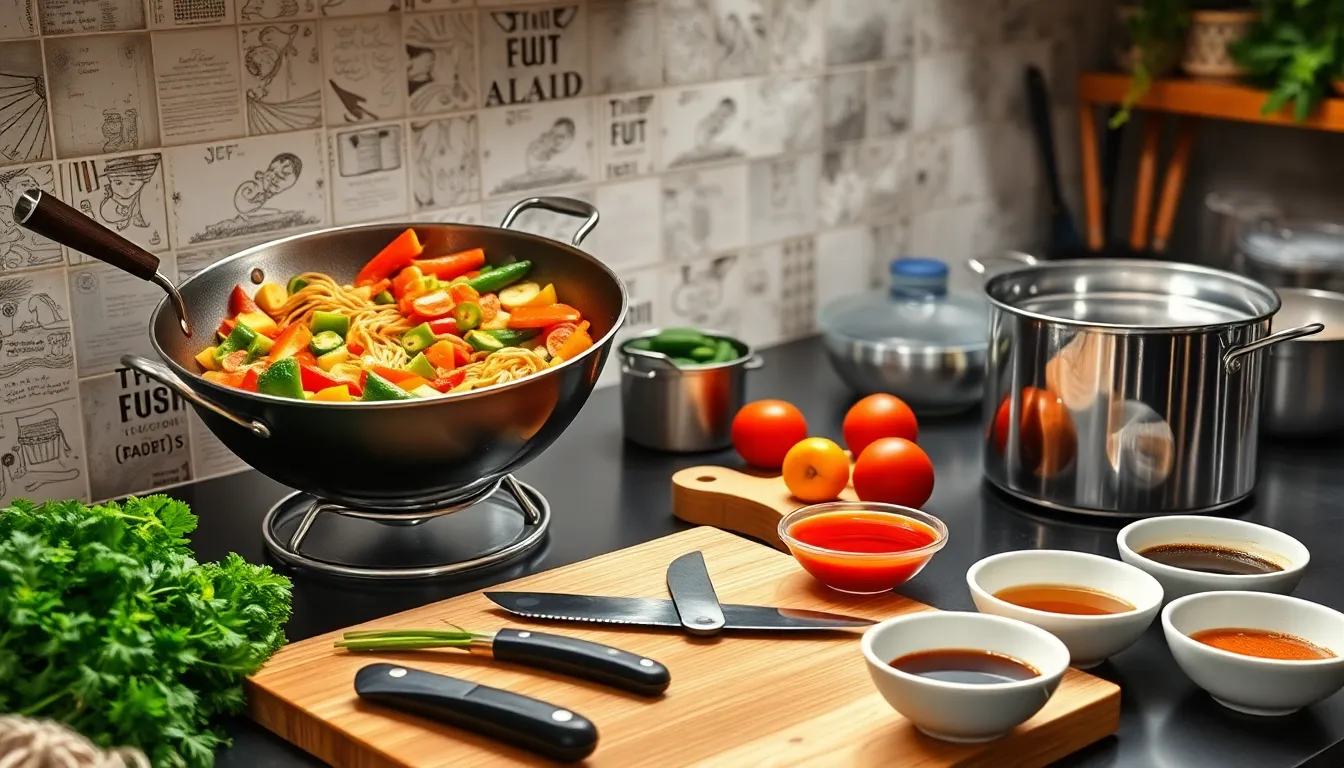
Your kitchen likely already contains most of the essential equipment for making authentic lo mein at home. A large wok or wide skillet serves as the most important piece of equipment since it provides ample space for tossing noodles and ingredients together while maintaining high heat distribution.
You’ll need a large pot for boiling the noodles along with a colander for draining them properly. The pot should hold at least 4 quarts of water to give the noodles room to cook evenly without sticking together.
A wooden spoon or wok spatula becomes crucial for stirring and tossing ingredients without damaging delicate noodles. These utensils work better than metal ones because they won’t scratch your cookware or break the noodles during the mixing process.
Small bowls for sauce preparation help you stay organized and cook efficiently. Having your sauce components measured and ready ensures smooth cooking since lo mein comes together quickly once you start.
Sharp knives for slicing vegetables and protein make prep work faster and safer. A chef’s knife handles most cutting tasks while a paring knife works well for detailed work like removing stems or trimming fat.
Measuring cups and spoons ensure accurate sauce ratios for consistent flavor every time you make this dish. Proper measurements prevent oversalting or creating sauce that’s too thick or thin.
A cutting board provides a stable surface for all your prep work. Choose one large enough to handle multiple ingredients without crowding your workspace.
| Equipment | Purpose | Alternative Options |
|---|---|---|
| Large wok or skillet | High-heat cooking and tossing | Heavy-bottomed sauté pan |
| Large pot (4+ quarts) | Boiling noodles | Stock pot or Dutch oven |
| Colander | Draining noodles | Fine-mesh strainer |
| Wooden spoon/wok spatula | Stirring without damage | Silicone spatula |
| Small mixing bowls | Sauce preparation | Measuring cups |
| Sharp knives | Ingredient prep | Food processor for vegetables |
Instructions
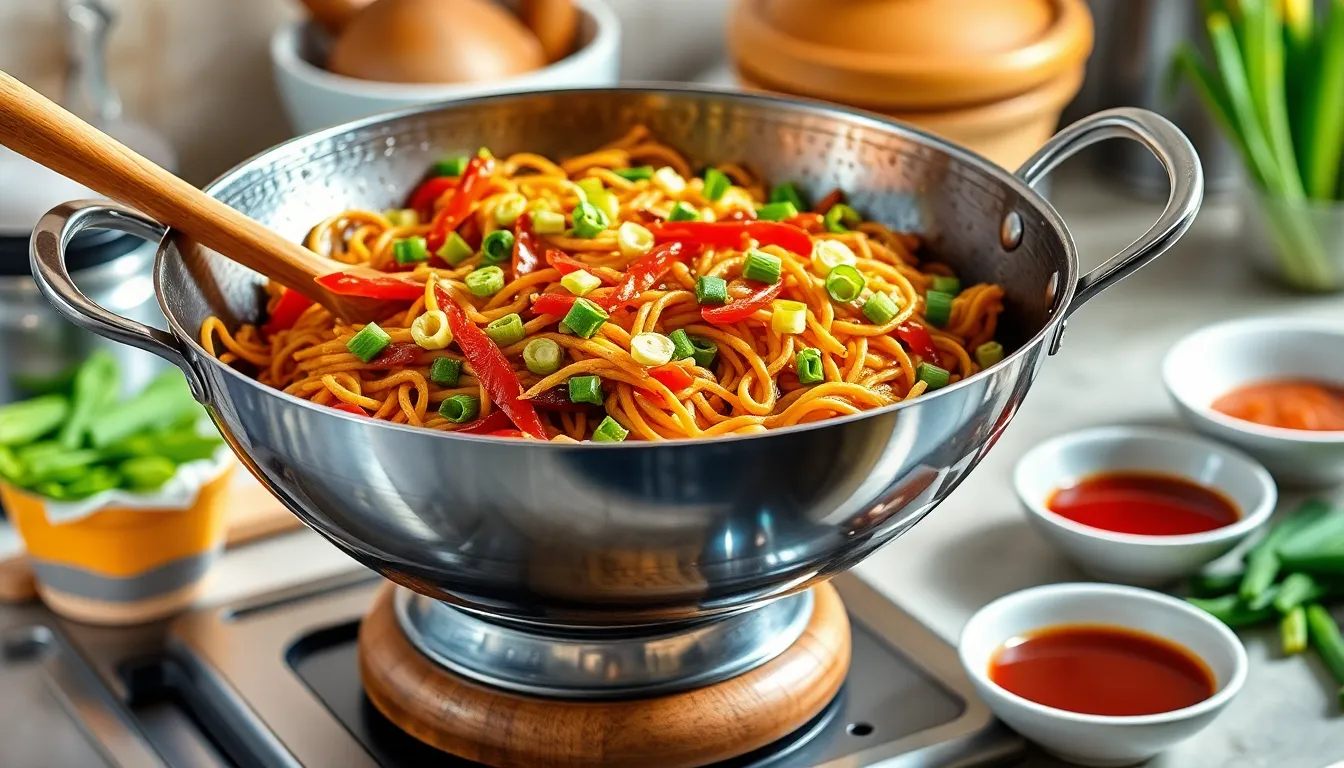
Follow these step-by-step instructions to create restaurant-quality lo mein that rivals your favorite takeout. The key to success lies in proper preparation and timing each component perfectly.
Prep the Ingredients
Slice your chosen protein into thin strips or bite-sized pieces for even cooking. Cut vegetables into uniform pieces approximately 1/4 inch thick to ensure they cook at the same rate. Mince 3 cloves of garlic and grate 1 tablespoon of fresh ginger using a fine grater.
Separate 2 green onions by slicing the white parts thinly and cutting the green tops into 1-inch pieces. Keep these components separate as they cook at different times. Measure all sauce ingredients into small bowls and arrange them near your cooking area for quick access during stir-frying.
Cook the Noodles
Bring 4 quarts of water to a rolling boil in your large pot. Add the lo mein noodles and cook according to package directions until al dente. Fresh noodles typically require 2-3 minutes while dried noodles need 4-6 minutes.
Test doneness by tasting a strand – it should be tender but still have a slight bite. Drain the noodles immediately in your colander and rinse briefly with cold water to stop the cooking process. Toss the drained noodles with 1 teaspoon of sesame oil to prevent sticking and set aside.
Make the Sauce
Whisk together 3 tablespoons soy sauce and 2 tablespoons oyster sauce in a small bowl. Add 1 tablespoon rice wine or dry sherry along with 1 teaspoon sesame oil. Incorporate 1/2 teaspoon sugar and 1/4 teaspoon white pepper for balanced flavor.
Stir the mixture until the sugar completely dissolves and the sauce appears smooth. Taste and adjust seasoning as needed – add more soy sauce for saltiness or sugar for sweetness. Set the prepared sauce within easy reach of your cooking station.
Stir-Fry the Vegetables and Protein
Heat 2 tablespoons of vegetable oil in your wok or large skillet over high heat until it shimmers. Add your protein first and stir-fry for 2-3 minutes until nearly cooked through. Push the protein to one side of the pan.
Add harder vegetables like carrots and bell peppers to the empty side and cook for 2 minutes. Include the minced garlic and ginger along with white parts of green onions. Stir-fry everything together for another minute until fragrant. Add softer vegetables like mushrooms and bean sprouts during the final 30 seconds to maintain their crisp texture.
Combine Everything Together
Add the cooked noodles to the wok and immediately pour the prepared sauce over everything. Use your wooden spoon or wok spatula to toss all ingredients together rapidly. Work quickly to coat every strand of noodle with the savory sauce.
Continue tossing for 1-2 minutes until the noodles heat through completely and absorb the sauce flavors. Sprinkle the green onion tops over the dish and give one final toss. Remove from heat immediately to prevent overcooking and serve while steaming hot.
Tips for Perfect Lo Mein
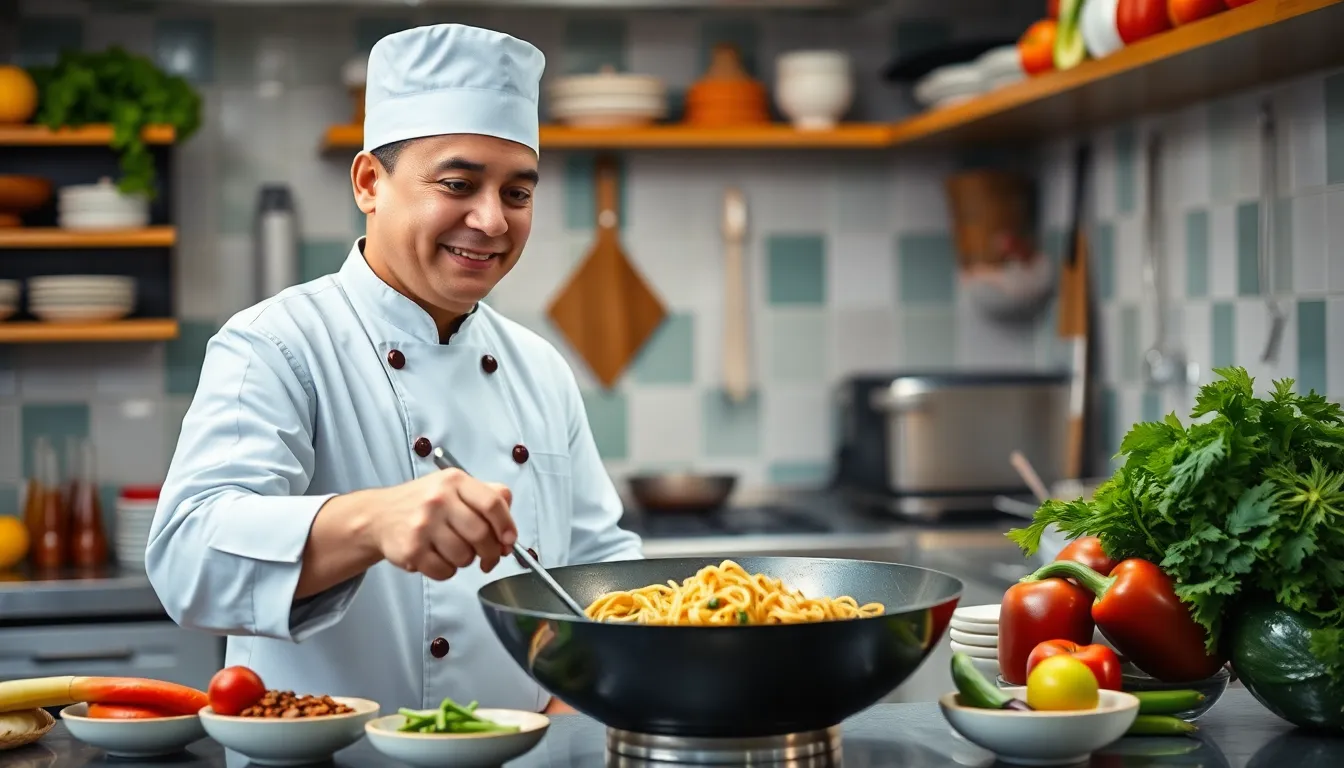
Master the art of noodle preparation by cooking them just until al dente. You want the noodles to have a slight bite since they’ll continue cooking when you toss them with the hot ingredients in your wok. Overcooking at this stage results in mushy noodles that break apart during stir-frying.
Control your heat levels throughout the cooking process. High heat works best for searing protein and achieving that characteristic wok hei flavor, but reduce the temperature slightly when adding delicate vegetables like bean sprouts or leafy greens. This prevents burning while maintaining the crisp texture that makes restaurant-style lo mein so appealing.
Prepare all ingredients before you start cooking. Lo mein comes together quickly once you begin stir-frying, leaving no time for chopping vegetables or mixing sauces mid-process. Having everything measured, sliced, and ready ensures smooth cooking and prevents overcooking any single component.
Drain your noodles thoroughly after boiling to remove excess water. Wet noodles create steam in the wok and prevent proper browning of other ingredients. Pat them dry with paper towels if necessary, and toss with a small amount of oil to prevent sticking.
Add sauce gradually rather than pouring it all at once. Start with about half your prepared sauce, toss everything together, then add more as needed. This technique prevents the dish from becoming too wet while ensuring every strand gets properly coated.
Work in batches if you’re cooking for a large group. Overcrowding your wok or skillet drops the temperature and causes ingredients to steam rather than sear. Cook in smaller portions to maintain that high heat that creates the best texture and flavor.
Reserve some pasta cooking water before draining your noodles. The starchy water helps bind the sauce to the noodles if your lo mein seems too dry. Add just a tablespoon or two to achieve the perfect consistency.
Taste and adjust seasoning at the end of cooking. Different brands of soy sauce and oyster sauce vary in saltiness, so your final dish might need a splash more sauce or a pinch of sugar to balance the flavors perfectly.
Variations and Substitutions
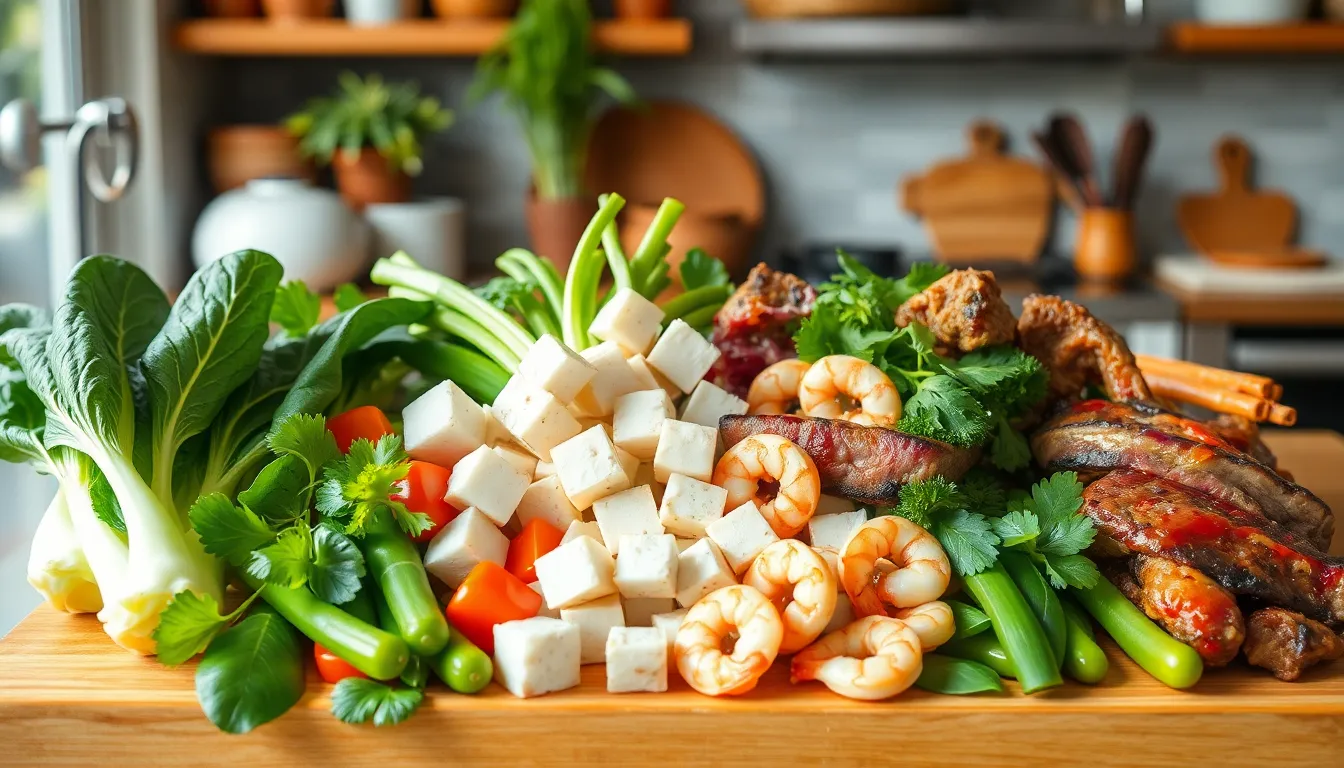
You can easily customize this classic lo mein recipe to match your dietary preferences and available ingredients. These flexible substitutions allow you to create countless variations while maintaining the authentic flavors.
Protein Options
You can substitute the traditional chicken with beef sirloin or flank steak cut into thin strips for a heartier texture. Shrimp works beautifully when added during the last 2-3 minutes of cooking to prevent overcooking. Pork tenderloin or ground pork creates rich umami flavors that pair perfectly with the savory sauce.
For vegetarian options, firm tofu pressed and cubed provides excellent protein while absorbing the sauce flavors. Tempeh crumbled into bite-sized pieces offers a nutty taste and substantial texture. You can also use scrambled eggs beaten with a pinch of salt for a protein-rich vegetarian version.
Seafood lovers can incorporate scallops seared for 2 minutes per side or crab meat folded in gently at the end. Fish fillets like cod or salmon work well when cut into chunks and cooked until flaky.
Vegetable Alternatives
You can replace traditional cabbage with bok choy stems and leaves separated for different cooking times. Snow peas and snap peas add crisp sweetness when stir-fried for just 1-2 minutes. Bell peppers in red, yellow, or orange provide vibrant color and crunch.
Mushroom varieties like shiitake, cremini, or oyster mushrooms contribute earthy depth to the dish. Bean sprouts create authentic restaurant texture when added during the final minute of cooking. Broccoli florets work perfectly when blanched first for 2 minutes.
For seasonal variations, you can use asparagus spears cut into 2-inch pieces during spring months. Zucchini and yellow squash sliced into half-moons offer mild flavors that absorb the sauce well. Fresh corn kernels provide natural sweetness that balances the salty elements.
Noodle Substitutes
You can use dried Chinese egg noodles when fresh lo mein noodles are unavailable, cooking them according to package directions until al dente. Ramen noodles without the seasoning packet work surprisingly well for a quick substitute. Spaghetti or linguine pasta creates an Italian-Chinese fusion when cooked to proper texture.
For gluten-free options, rice noodles like pad thai noodles provide similar chewy texture when soaked in hot water until pliable. Shirataki noodles offer a low-carb alternative that requires thorough rinsing and brief cooking. Soba noodles made from buckwheat flour add nutty flavors and work well with lighter vegetables.
Vegetable noodles create healthy alternatives using spiralized zucchini, carrot ribbons, or spaghetti squash strands. These options require minimal cooking time and should be added during the final tossing stage to prevent mushiness.
Make-Ahead Instructions
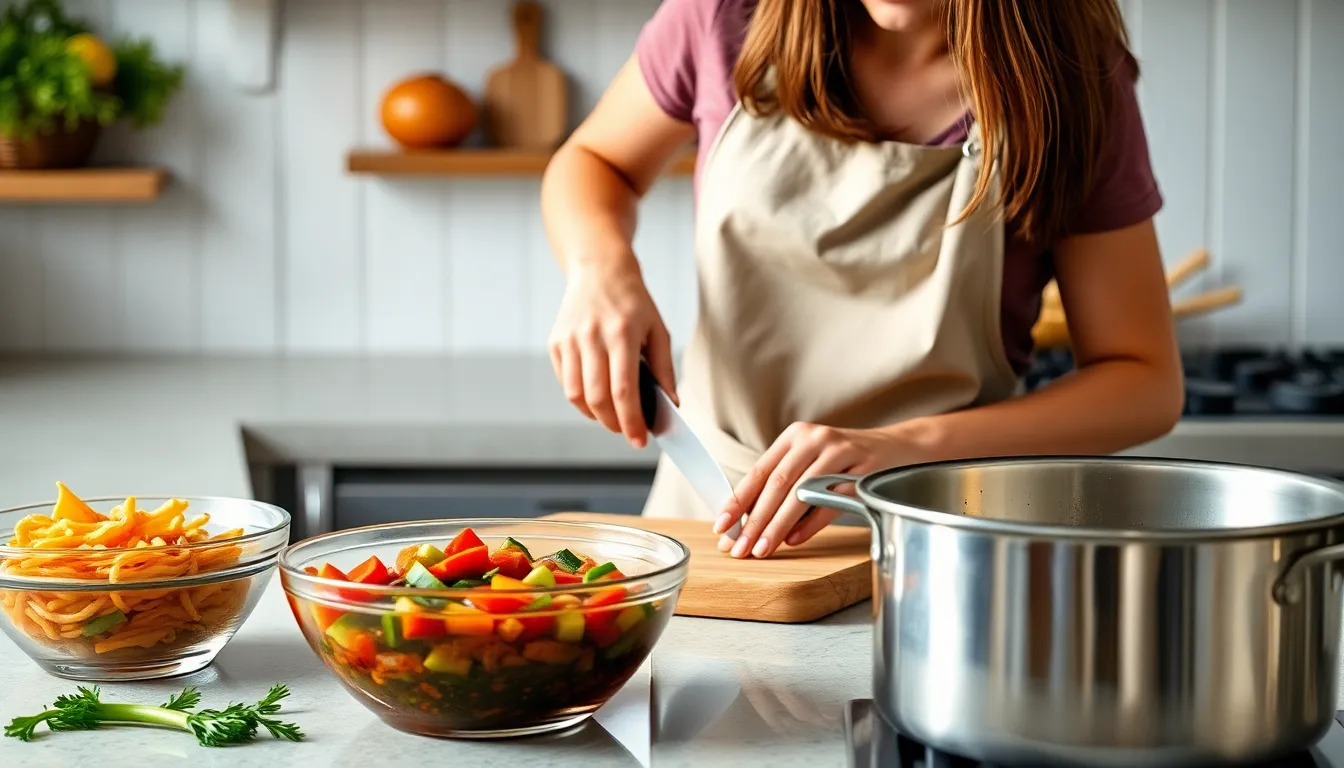
You can prepare several components of lo mein up to 24 hours in advance to streamline your cooking process. Start by washing and chopping all vegetables then store them in separate airtight containers in the refrigerator. Your protein can be sliced and marinated overnight which actually enhances the flavor profile.
Mix your lo mein sauce completely and refrigerate it in a sealed container for up to 3 days. The flavors meld together beautifully during this time creating an even richer taste. Keep garlic and ginger minced fresh in small containers as their potency remains strongest when prepared the day of cooking.
Cook your noodles up to 2 hours ahead following the package directions but reduce cooking time by 1 minute. Drain them thoroughly and toss with a small amount of sesame oil to prevent sticking. Store the noodles at room temperature covered with a damp towel.
Partially cook your protein 75% through then cool it completely before refrigerating. This technique ensures your meat or tofu won’t overcook during the final stir frying stage. Vegetables can be blanched quickly in boiling water for 30 seconds then shocked in ice water to maintain their crisp texture.
When ready to serve reheat your wok or skillet over high heat. Add the partially cooked protein first to finish cooking then incorporate the prepped vegetables. Toss in your room temperature noodles and pour the prepared sauce over everything. The entire final assembly takes only 3 to 4 minutes.
Store any leftover assembled lo mein in the refrigerator for up to 3 days. Reheat portions in a hot skillet with a splash of water or chicken broth to restore moisture and prevent the noodles from drying out.
Storage and Reheating
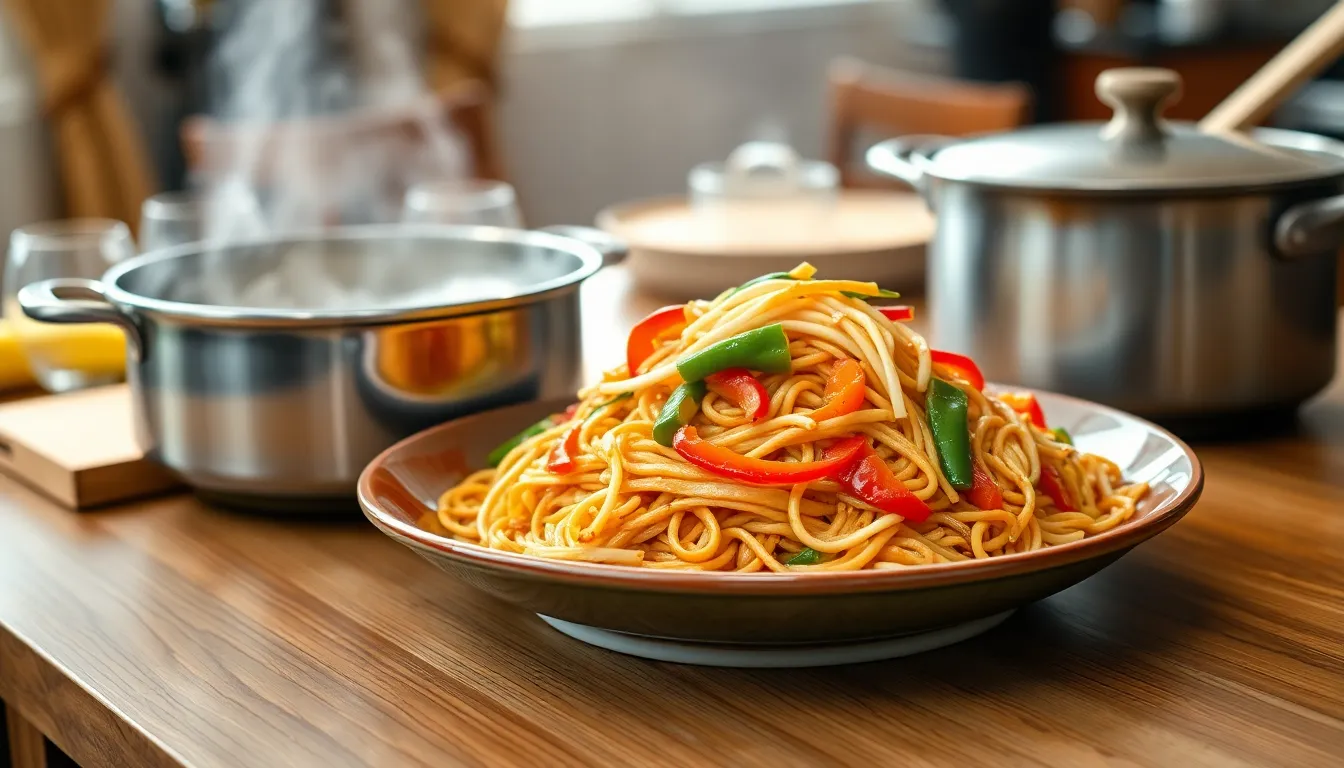
Store your leftover lo mein in airtight containers in the refrigerator for up to three days. The noodles will absorb some of the sauce during storage, which is completely normal and won’t affect the taste significantly.
Transfer cooled lo mein to glass or plastic containers with tight-fitting lids to prevent moisture loss. Divide large portions into smaller containers for easier reheating and portion control. Label containers with the date to track freshness.
Avoid freezing lo mein as the noodles become mushy and lose their ideal texture when thawed. The vegetables also release excess moisture during freezing, creating a watery consistency that compromises the dish quality.
Reheat lo mein using the stovetop method for best results. Add one to two tablespoons of water or chicken broth to a large skillet over medium heat. Add the cold lo mein and toss gently with tongs or a wooden spoon for two to three minutes until heated through.
Microwave reheating works as a quick alternative. Place lo mein in a microwave-safe dish and add one tablespoon of water. Cover with a damp paper towel and heat in 30-second intervals, stirring between each interval until warmed completely.
Steam reheating preserves the noodle texture exceptionally well. Set up a steamer basket over simmering water and place the lo mein inside for three to four minutes. This method prevents the noodles from drying out while maintaining their chewy consistency.
Add a splash of soy sauce or oyster sauce during reheating if the flavors seem muted. Fresh vegetables like bean sprouts or scallions can brighten up day-old lo mein and restore some of the original crunch and freshness.
Conclusion
You now have everything you need to create restaurant-quality lo mein in your own kitchen. With the right ingredients equipment and techniques you’ll be tossing perfectly sauced noodles like a pro in no time.
The beauty of homemade lo mein lies in its versatility and speed. Whether you’re craving a quick weeknight dinner or preparing meals ahead of time this recipe adapts to your schedule and dietary preferences.
Don’t be afraid to experiment with different proteins vegetables and sauce combinations. Each variation you try brings you closer to discovering your perfect lo mein recipe that rivals any takeout joint in town.

